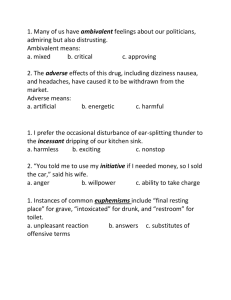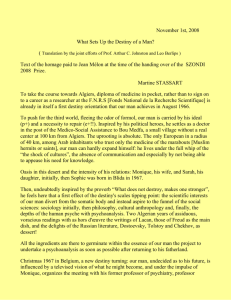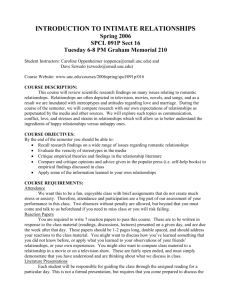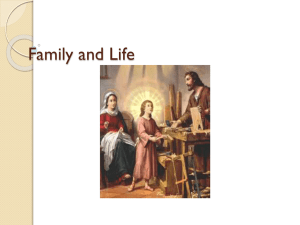The genotropistic theory of the choice in love
advertisement
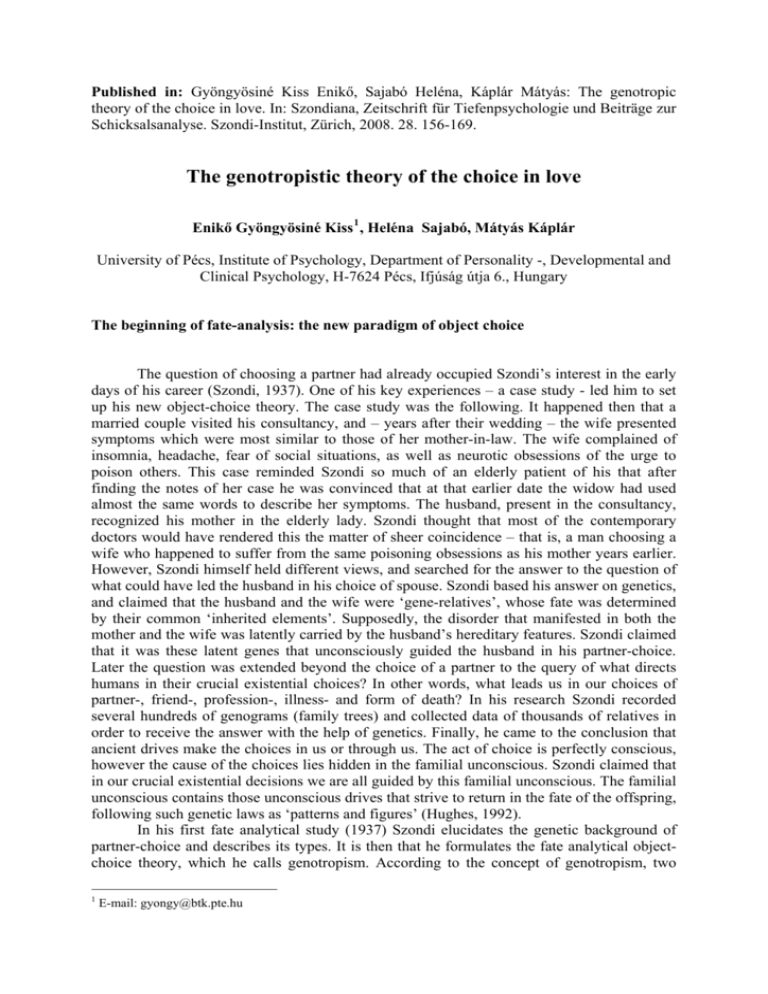
Published in: Gyöngyösiné Kiss Enikő, Sajabó Heléna, Káplár Mátyás: The genotropic theory of the choice in love. In: Szondiana, Zeitschrift für Tiefenpsychologie und Beiträge zur Schicksalsanalyse. Szondi-Institut, Zürich, 2008. 28. 156-169. The genotropistic theory of the choice in love Enikő Gyöngyösiné Kiss 1 , Heléna Sajabó, Mátyás Káplár University of Pécs, Institute of Psychology, Department of Personality -, Developmental and Clinical Psychology, H-7624 Pécs, Ifjúság útja 6., Hungary The beginning of fate-analysis: the new paradigm of object choice The question of choosing a partner had already occupied Szondi’s interest in the early days of his career (Szondi, 1937). One of his key experiences – a case study - led him to set up his new object-choice theory. The case study was the following. It happened then that a married couple visited his consultancy, and – years after their wedding – the wife presented symptoms which were most similar to those of her mother-in-law. The wife complained of insomnia, headache, fear of social situations, as well as neurotic obsessions of the urge to poison others. This case reminded Szondi so much of an elderly patient of his that after finding the notes of her case he was convinced that at that earlier date the widow had used almost the same words to describe her symptoms. The husband, present in the consultancy, recognized his mother in the elderly lady. Szondi thought that most of the contemporary doctors would have rendered this the matter of sheer coincidence – that is, a man choosing a wife who happened to suffer from the same poisoning obsessions as his mother years earlier. However, Szondi himself held different views, and searched for the answer to the question of what could have led the husband in his choice of spouse. Szondi based his answer on genetics, and claimed that the husband and the wife were ‘gene-relatives’, whose fate was determined by their common ‘inherited elements’. Supposedly, the disorder that manifested in both the mother and the wife was latently carried by the husband’s hereditary features. Szondi claimed that it was these latent genes that unconsciously guided the husband in his partner-choice. Later the question was extended beyond the choice of a partner to the query of what directs humans in their crucial existential choices? In other words, what leads us in our choices of partner-, friend-, profession-, illness- and form of death? In his research Szondi recorded several hundreds of genograms (family trees) and collected data of thousands of relatives in order to receive the answer with the help of genetics. Finally, he came to the conclusion that ancient drives make the choices in us or through us. The act of choice is perfectly conscious, however the cause of the choices lies hidden in the familial unconscious. Szondi claimed that in our crucial existential decisions we are all guided by this familial unconscious. The familial unconscious contains those unconscious drives that strive to return in the fate of the offspring, following such genetic laws as ‘patterns and figures’ (Hughes, 1992). In his first fate analytical study (1937) Szondi elucidates the genetic background of partner-choice and describes its types. It is then that he formulates the fate analytical objectchoice theory, which he calls genotropism. According to the concept of genotropism, two 1 E-mail: gyongy@btk.pte.hu individuals whose genetic material is similar, may carry latently reappearing hereditary tendencies, and will mutually attract each other. By 1944 Szondi had extended the choices that determine our fate beyond the choice of a partner to the choice of friends, illness and the form of death. Ancient drives lying hidden in the familial unconscious also play a role in backing and guiding one’s choices. In his book (1937) Szondi distinguished the following types of marriage choices: 1. Healthy individual chooses a healthy partner (“healthy x healthy”). This is the most frequent occurrence in the population when the partners remain healthy throughout their lives while their blood relatives bear hereditary disorders. Szondi described a case when “… the parents are not blood relatives, neither of them is deaf and dumb, yet two of their children are deaf and dumb and through the family inquiry we learn that the mother of the husband as well as a paternal uncle of the wife were deaf and dumb. The hybrid character of this couple is well demonstrated also by the circumstance that the recessive sick ancestor is found in manifesting form among the brothers and sisters of one of the parties or among their children.” (Szondi, 1937, 36. p.) Szondi thought that in this type of marriage the heterozygote, manifest healthy individuals were hiding the same “ancestor”, the same inherited disease. 2. Healthy individual chooses a sick partner (healthy x sick). In this type a healthy partner chooses a sick mate. Refer to Szondi the occurrence of this type in the population is between 15-20 %. One of Szondi’s cases is the next: “The marriage was contracted between the granddaughter of a blind man with a blind individual.” (1937, 35. p.) This, and many other cases also confirmed that a healthy relative of a sick family member may choose a mate with the identical manifest disease. Szondi explained this kind of partner choice also with Mendel’s laws, when “the ancestor that was manifest in the mate chosen, had been hidden and repressed and yet present in the chooser”. 3. Sick individual chooses a sick partner (sick x sick). The occurrence of this type is less than 1 % in the population. One of Szondi’s the cases was the case of a criminal couple where the husband and the wife were also criminals and they had a son who was a thief. In the couple’s family trees came up other criminal family members – in both lineage of the mates. Summarizing the results of the case studies show that the choosing partners bear the identical diseases in a manifest or recessive form and this inheritance attract the two partners to each other (Bereczkei, T., Gyöngyösiné Kiss, E., 2001). Other personality theories in personality psychology on choosing a partner In personality psychology one can find two main opposite theories on growing up an interpersonal attraction between two individuals: 1. the theory of similarity, and 2. the theory of complementarities. “Similis simili gaudet” – tells the Latin proverb, what means that the similarities attract people to each other. Many psychological researches were made on this topic and the results confirmed that the similarities in attitudes, personality features, personal constructions of world view, and other kind of similarities in social, demographic factors strengthen the attraction among people (Bentler & Newcomb 1980, Byrne & Blaylock 1963, Byrne 1971, Kelly & Conley 1987, Seyfried, B. A. 1977, Vargha A. 1991, 1994). We mention only two studies from the long literature. One of the studies was Bentler & Newcomb’s (1980) study, who administered the Bentler Psychological Inventory, the Bentler Interactive Psychological Inventory, the Sexual Behavior Inventory, and a background questionnaire to 77 newly married couples. Four years later these couples were followed up to determine their marital status and satisfaction. The findings indicated that a correlational similarity as well as mean differentiation between partners was higher in the still-married group than the divorced group and a longitudinal prediction of marital adjustment was possible. It was also suggested that variation in marital outcome is most accurately predicted from personality and not demographic variables. Kelly & Conley (1987) examined the marital stability (divorce or remaining married) and marital satisfaction (within the group that remains married), they investigated 300 couples who were followed from their engagements in the 1930s until 1980. Twenty-two of the couples broke their engagements of the 278 couples who married, 50 got divorced at some time between 1935 and 1980. The finding showed that personality characteristics were important predictors of both marital stability and marital satisfaction. They also found that three aspects of personality most strongly related to marital outcome: the neuroticism of the husband, the neuroticism of the wife, and the impulse control of the husband. The second theory is the hypothesis of complementarities – this view tells that the opposite sides attract people to each other. Refer to the theorists the opposite features are beneficial for the mates wherewith they fulfil each other’s needs (Winch, R. F., 1958). One of the confirmatory researches was Winch, Ktsanes, T. & Ktsanes V. (1955) examination where personality data were obtained from 25 middle class, university trained couples. They made interwievs supporting the hypothesis that these husbands and wives selected each other on the basis of complementary needs. These data were analyzed for the purpose of formulating more specific hypotheses concerning the nature of "complementariness." An important dimension of marital choice in the group sampled appears to be the assertive-receptive dimension, high "assertives" tending to marry high "receptives." Refer to some researchers it is possible to integrate the two seemingly opposite theories (similarity versus complementary), the psychological researches emphasize the basic role of similarity of the partners and beyond the similarities the complementary features can be useful for the parties (Kerckhoff & Davis, 1962, Forgas, 1986). Empirical study In our paper we examined the ‘similarity theory’ and asked what kind of correspondences we could find in couples’ personality features. Our hypotheses were: 1. the ‘similarity theory’ is the basis of our object choice, 2. Szondi’s genotropistic theory can be examined by couples’ Szondi Test’s results. Method The sample consisted of 45 couples (90 subjects) with whom we took the 10- profileSzondi Test (all together we got 900 Szondi Test profiles). The mean age of the sample was 24.5 years, and the subjects had a high school graduation or diploma. We chose those couples into the sample who had been in relationship at least 1 year. We evaluated the tests results by using the quantitative methods of the Szondi test. We especially examined the pairs’ drive class, the proportional latencies (Linnean drive analysis) and the Dur-Moll ratio. Besides the clinical analyses we made statistical analyses as well. We compared the choices of the pairs by rank correlation analysis (in each factors we compared the ranks of the pairs’ choices [+, -, +/-, 0 aggregate data]). By this mathematical analysis we got the patterns of the pairs’ choices in each factors. Finally we asked the subjects to make a hypothetic Szondi Test about his/her partner’s choices. (What the subject thought what would be his/her partner’s choice in the Szondi Test?) We compared these hypothetic 10-profile-tests with the partner’s own testprofiles. Results In our first count we made some general statistic analyses of the sample. We summarized the factor reactions (+, -, +/-, 0) and assessed the frequency of the factor reactions in percents. The following tables show the mean profile of the women, men, and the common mean profile (women and men) as well. (See Table 1, 2, 3.) The mean profile was in all cases: h+, s-, e-, hy-, k-, p+, d 0, -, m+. 1. Mean profile of the women: h+ s- e- hy- k- p+ d 0, - m+ 0 + +/- h 6 18 11 4 h% s s% e e% hy hy% k k% p p% d d% m 15,4 5 12,5 13 31 3 8,1 5 13,2 9 23,7 14 36,8 5 30 9 21,4 2 5,4 3 7,9 26 68,4 9 23,7 25 46,2 12 28,2 16 7,9 14 36,8 6 40 17 40,5 29 78,4 23 60,5 3 10,3 7 17,5 3 7,1 3 8,1 7 18,4 0 0 1 2,6 5 m% 12,2 61 14,6 12,2 2. Mean profile of the men: h+ s- e- hy- k- p+ d 0, - m+ 0 + +/- h 11 17 8 5 h% s s% e e% hy hy% k k% p p% d d% m m% 26,8 0 0 10 27 4 9,5 5 12,2 7 17,1 13 34,2 2 5,1 4,8 2 4,9 31 75,6 10 26,3 32 82,1 41,5 8 21,1 12 32,4 2 19,5 28 73,7 13 35,1 33 78,6 27 65,9 3 7,3 13 34,2 3 7,7 12,2 2 5,3 2 5,4 3 7,1 7 17,1 0 0 2 5,3 2 5,1 3. The common mean profile: h+ s- e- hy- k- p+ d 0, - m+ 0 + +/- h 17 35 19 9 h% 21,25 43,75 23,75 11,25 s s% e e% 5 6,41 23 29,11 20 25,64 21 26,58 44 56,41 30 37,97 9 11,54 5 6,329 hy hy% k k% p p% d d% m m% 7 8,86 10 12,66 16 20,25 27 35,53 7 8,75 4 5,06 5 6,329 57 72,15 19 25,00 57 71,25 62 78,48 50 63,29 6 7,595 27 35,53 9 11,25 6 7,59 14 17,72 0 0 3 3,95 7 8,75 The other results of the quantitative analyses of the Szondi Test profiles were the following: The Social index of the sample is 44%. (Refer to Szondi between 40-50 % is normal). The Symptom percent is 35 % (the normal rate is between 20-30%) – it’s a bit higher than the normal range and means that the subjects have more anxiety. The Quotient of Tendency Tension of the sample is Q = 2.22, this value is normal between 1-3. We compared the pairs’ Psychosexual index (Dur-Moll method) to each other and got significant correlation (at the level 0.05) in the Dur-Moll percent, r =-0,325, which shows that the partners complete each other in their sexual characteristics. These analyses confirm that our sample is really a healthy, normal sample. In the next step we counted the subjects drive classes, proportional tendencies (Linnean drive analysis with the drive perils and the symptoms) and compared the partners’ results with each other. Our findings were very interesting and establish Szondi’s genotropistic partner choice theory. From the 45 pairs 13 couples have totally the same drive classes (means 30 % of the sample) and in other 6 couples (13%) we got the identical the drive class in the vectors but the factors were the opposite. In 14 couples (31 %) we got that in the proportional tendencies one’s root is the symptom of the partner (it means that what was at the first place of the Linnean order of the subject that was at the fourth place of his/her partner’s Linnean order); in other 8 couples (18 %) it was nearly the same result, the only difference was that we found the same vector with the opposite factor in the proportional tendencies’ first and last places. In 4 couples (8% of the sample) we couldn’t find any connection among these data. (See Table 4.) Szondi (1947) wrote in his book about the genetic, biological background of the drives and drive needs, and he also emphasized that it was possible to change drive class during one’s life, but it could happen only according to strict genetic, biological rules and not consciously or by chance. He mentioned for example that in the Linnean order usually the first and the fourth drive could change place and he hypothesized biological relationship behind this phenomenon. In our empirical research we got the similar results, in more cases (in 49% of the sample) we found that what was at one’s first place in the proportional tendencies that was at the last place at the partner. Summarizing the clinical interpretations’ findings in 92% of the sample it was possible to explain the partner choice with Szondi’s genotropistic theory. 4. The results of the quantitative analysis Identical drive class at the couples (Cm+, Schk-, Schp+, Pe-, Phy-, Sh+, the same hereditary structure in the background, the same „root” – which determines the character) Proportional tendencies: one’s root is the symptom factor of the partner Proportional tendencies: one’s root is the symptom of the partner (same vector but the opposite factor) Identical drive class in the vector but the factors are opposite Other cases (without classification) 13 couples = 30% 14 couples = 31% 8 couples = 18% 6 couples = 13% 4 couples = 8% We continued our analysis with other statistical approaches; we wanted to get statistical confirmation of our hypotheses besides the clinical interpretations and results. In the first step we made the rank order of the factor choice frequency (+, -, +/-, 0) of the subjects in each factors. After it we compared the couples rank order if they had the same factor frequency order or the opposite as their partner’s. By this factor frequency method we could get the couples’ pattern of choices. In the next tables one can see the frequency of choices (in how many times were the same or the opposite rank order of the partners in each factors in the sample) and in the table under it the correlations, if the rank order correlated to their partner’s choice frequency or not. According to the results of the 5.a and 5.b tables one can find that in all factors – except the s factor – the partners rank frequency correlated to each other (when the value is between 0.3-0.5 it means a good correlation and above 0.5 a high correlation). In the case of the s factor the partners had a negative correlation what means that the partners completed each other in sexuality, so they didn’t choose the same pictures. Shortly our finding was that in the s factor the “complementary theory” strengthened while in the other factors the “similarity theory”. 5. a. Frequency of choices h -1 6 s +1 11 -1 12 e +1 9 -1 10 +1 12 -1 2 hy +1 23 k -1 6 p +1 17 -1 4 d +1 22 -1 5 m +1 12 -1 8 +1 21 +1 = same rank order as the partner - 1 = opposite rank order as the partner 5. b. Correlation Median h 0,27 s -0,32 e 0,32 hy 0,58 k 0,5 p 0,63 d 0,54 m 0,5 We controlled our results – if they were not artefacts - by comparing random Szondi Test profiles (not the couples’ profiles). If our concept was right we shouldn’t get correlation between these random factor frequency. Table 6.a and 6.b shows that we didn’t get correlations (in the cases of the hy, k, p, d, m factors we got correlations because of the speciality of the sample, see the parameter of the mean profiles, Table 1, 2, 3!), so this control reinforced that our count was right. 6. a. Frequency of choices – control by random profiles h -1 7 s +1 11 -1 13 e +1 10 -1 10 +1 10 hy -1 +1 4 20 k -1 4 p +1 18 -1 2 d +1 21 -1 5 m +1 9 -1 8 +1 15 6. b. Correlation – control by random profiles h 0 Median s -0,05 e 0,1 hy 0,5 k 0,35 p 0,63 d 0,23 m 0,25 In the second part of our examination we asked the subjects to make a hypothetic Szondi Test about his/her partner’s choices. (The instruction was: “What do you think which two photos like your partner the best?”, “What do you think which two photos dislike your partner the most?”) We compared these hypothetic 10-profile-tests with the partner’s own testprofiles. We worked up the data by the rank order statistical analysis and this time we found higher (!) correlations (in each factors) than in the cases of the partners’ real Szondi Tests. (See table 7.a, 7.b, 8. a, 8. b). These results lead us to two main conclusions: 1. there is the wish in people to see the partner as if he/she were much more similar to them (as the reality), 2. there is no difference in women and men, the wish is universal in both sex. It seems that people look for similarity in their partner choice; these results strengthen Szondi’s genotropistic theory as well. 7. a. Frequency of choices: women and their hypothetic partners’ choice h -1 2 s +1 21 -1 6 e +1 21 -1 2 +1 20 -1 0 hy +1 25 k -1 4 p +1 27 -1 0 d +1 25 -1 4 m +1 23 -1 3 +1 25 7. b. Correlation Median h 0,77 s 0,605 e 0,78 hy 0,8 k 0,79 p 0,78 d 0,82 m 0,77 8. a. Frequency of choices: men and their hypothetic partners’ choice h -1 3 s +1 24 -1 4 e +1 26 -1 0 +1 23 hy -1 +1 0 30 k -1 1 p +1 27 -1 2 d +1 27 -1 2 m +1 18 -1 2 +1 29 8. b. Correlation Median h 0,77 s 0,79 e 0,82 hy 0,81 k 0,755 p 0,81 d 0,63 m 0,82 Finally we controlled our results by random analyses; we compared the subject’s choice with random hypothetical Szondi Test profiles and this time we didn’t get correlations. See Table 9.a, 9.b (in the cases of the hy, k, p, d, m factors we got correlations because of the speciality of the sample, see the parameter of the mean profiles, Table 1, 2, 3!) Table 10. a, and 10.b show that the values much more lower than the original choices (see Table 8.a, 8.b). 9. a. Frequency of choices: women and random hypothetic partners’ choice h -1 10 s +1 11 -1 11 e +1 9 -1 10 +1 6 -1 5 hy +1 18 k -1 5 p +1 17 -1 4 d +1 16 -1 5 m +1 7 -1 4 +1 19 9. b. Correlation - control by random profiles Median h -0,17 s -0,06 e -0,11 hy 0,325 k 0,5 p 0,58 d 0,225 m 0,58 10. a. Frequency of choices: men and random hypothetic partners’ choice h -1 13 s +1 17 -1 12 e +1 19 -1 8 +1 10 hy -1 +1 2 21 k -1 5 p +1 20 -1 6 d +1 19 -1 6 m +1 7 -1 4 +1 22 10. b. Correlation - control by random profiles Median h 0,21 s 0,5 e 0,36 hy 0,5 k 0,54 p 0,5 d 0,21 m 0,58 Summarizing our results: in our study we examined the ‘similarity theory’ and asked what kind of correspondences we could find in couples’ personality features. Our hypotheses were: 1. the ‘similarity theory’ is the basis of our object choice, 2. Szondi’s genotropistic theory can be examined by couples’ Szondi Test’s results. The clinical interpretation (on the basis of quantitative methods) and the statistical analyses confirmed these two hypotheses. “Similis simili gaudet” – significant similarities attract and hold people together. The results reinforced Szondi’s genotropistic object choice as well. Summary Szondi published his first fate-analytical study „Analysis of Marriages” in 1937 in which he introduced his new paradigm on choosing a love-partner. Refer to Szondi one of the first important genotropistic operation of the familial unconscious was manifested in the choice of love, which he designated libidinal tropism. The aim of our research was to examine Szondi’s libidinal tropism theory whether it could be verify on the ground of the love-partners’ 10-profile-Szondi Tests. We took up the 10-profile-Szondi test with 45 love-pairs (90 healthy subjects) whose ages were between 20-35, and who were in relationship at least for 1 year. We evaluated the tests results by using the quantitative clinical method of the Szondi test. We especially examined the pairs’ drive class, the proportional latencies (Linnean drive analysis) and the Dur-Moll ratio. Besides the clinical analyses we made statistical analyses as well. We compared the choices of the pairs by rank correlation analysis (in each factors we compared the rank orders of the pairs choices [+, -, +/-, 0 aggregate data]). By this mathematical analysis we got the patterns of the pairs’ choices in each factors. Finally we asked the subjects to make a hypothetic Szondi Test about his/her partner’s choices. We compared these hypothetic 10profile-tests with the partner’s own test-profiles. Results: the clinical and the statistical analyses confirmed the grounds of the „genotropistic” theory and “similarity theory” in personality psychology. We interpreted this results that the deeper personality structure determines - unconsciously - our choice in love. In modern personality psychology this deeper personality structure can be the inherited, biological based temperament - or character factors of personality. Literature 1. Bentler, P. M., Newcomb, M. D. (1978). Longitudinal study of marital success and failure. In: Journal of Consulting and Clinical Psychology, 46, 1053-1070. 2. Bereczkei, T., Gyöngyösiné Kiss, E. (2001). Sorsanalízis és genetika: családfakutatás, párválasztás, öröklődés. (Fate-analysis and genetics: Family-tree research, choice of a partner, heredity) In: Magyar Pszichológiai Szemle (Hungarian Journal of Psychology), 56. 71-90. 3. Byrne, D. (1971). The Attraction Paradigm. New York, Academic Press. 4. Byrne, D., Blaylock, B. (1963) Similarity and assumed similarity between husbands and wives. In: Journal of Abnormal and Social Psychology, 67, 636-640. 5. Cattel, R. B., Nesselroade, J. R. (1967). Likeness and completeness theories examined by Sixteen Personality factor measures on stably and unstably married couples. In: Journal of Personality and Social Psychology, 7, 351-361. 6. Forgas, Joseph P. (1986) Interpersonal Behaviour: The Psychology of Social Interaction Elsevier Science Publishing Company. 7. Gyöngyösiné Kiss E., Sajabó H., Káplár M. (2008). The genotropic theory of choice in love. Paper presented at the 18th Szondi International Society Congress, 10-12 July, 2008, Lisbon, Portugal. 8. Hughes, Richard A. (1992) Return of the Ancestor. (American university studies. Series VII, Theology and religion) New York, Peter Lang Publishing. 9. Kelly, E. L., Conley, J. J. (1987). Personality and compatibility: A prospective analysis of marital stability and marital satisfaction. In: Journal of Personality and Social Psychology, 52, 27-40. 10. Kerckhoff, A. C., Davis K. E. (1962). Value consensus and need complementarity in mate selection. In: American Social Review, 27, 295-303. 11. Seyfried, B. A. (1977). Complementarity in interpersonal attraction. In: S. Duck (ed.): Theory and practice in interpersonal attraction. Academic Press, London, 167-184. 12. Szondi, L. (1937). Analysis of marriages. An attempt at a theory of choice in love. The Hague, M. Nijhoff. 13. Szondi, L. (1944). Schicksalsanalyse. Wahl in Liebe, Freundschaft, Beruf, Krankheit und Tod. Basel, Schwabe. 14. Szondi, L. (1947). Lehrbuch der Experimentelle Triebdiagnostik. Bern, Huber. 15. Till, A., Freedman, E. M. (1978). Complementary versus similarity of traits operating in the choice of marriage and dating partners. In: The Journal of Social Psychology, 105, 147148. 16. Vargha, A. (1991). Coping strategies and marital compatibility. Paper presented at the 2 European Congress of Psychology, 8-12 July, 1991. Budapest, Hungary. nd 17. Vargha, A. (1994). A Szondi-teszt pszichometriája. (The Psychometry of the Szondi Test). Budapest, Universitas Könyvkiadó. 18. Winch, R. F. (1958). Mate selection: A study in complementary needs. Harper & Row, New York. 19. Winch, R. F., Ktsanes T., Ktsanes V. (1955). Empirical elaboration of the theory of complementary needs in mate selection. In: Journal of Abnormal and Social Psychology, 51, 508-513.



